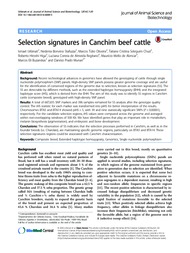Selection signatures in Canchim beef cattle
Selection signatures in Canchim beef cattle
Autoria: URBINATI, I.; STAFUZZA, N. B.; OLIVEIRA, M. T.; CHUD, T. C. S.; HIGA, R. H.; REGITANO, L. C. de A.; ALENCAR, M. M. de; BUZANSKAS, M. E.; MUNARI, D. P.
Resumo: Background: Recent technological advances in genomics have allowed the genotyping of cattle through single nucleotide polymorphism (SNP) panels. High-density SNP panels possess greater genome coverage and are useful for the identification of conserved regions of the genome due to selection, known as selection signatures (SS). The SS are detectable by different methods, such as the extended haplotype homozygosity (EHH); and the integrated haplotype score (iHS), which is derived from the EHH. The aim of this study was to identify SS regions in Canchim cattle (composite breed), genotyped with high-density SNP panel. Results: A total of 687,655 SNP markers and 396 samples remained for SS analysis after the genotype quality control. The iHS statistic for each marker was transformed into piHS for better interpretation of the results. Chromosomes BTA5 and BTA14 showed piHS>5, with 39 and nine statistically significant SNPs (P<0.00001), respectively. For the candidate selection regions, iHS values were computed across the genome and averaged within non-overlapping windows of 500 Kb. We have identified genes that play an important role in metabolism, melanin biosynthesis (pigmentation), and embryonic and bone development. Conclusions: The observation of SS indicates that the selection processes performed in Canchim, as well as in the founder breeds (i.e. Charolais), are maintaining specific genomic regions, particularly on BTA5 and BTA14. These selection signatures regions could be associated with Canchim characterization.
Ano de publicação: 2016
Tipo de publicação: Artigo de periódico
Unidade: Embrapa Agricultura Digital
Observações
1 - Por padrão são exibidas publicações dos últimos 20 anos. Para encontrar publicações mais antigas, configure o filtro ano de publicação, colocando o ano a partir do qual você deseja encontrar publicações. O filtro está na coluna da esquerda na busca acima.
2 - Para ler algumas publicações da Embrapa (apenas as que estão em formato ePub), é necessário ter, no celular ou computador, um desses softwares gratuitos. Sistemas Android: Google Play Livros; IOS: iBooks; Windows e Linux: software Calibre.
Acesse outras publicações
Acesse a Base de Dados da Pesquisa Agropecuária (BDPA) para consultar o acervo completo das bibliotecas da Embrapa.

